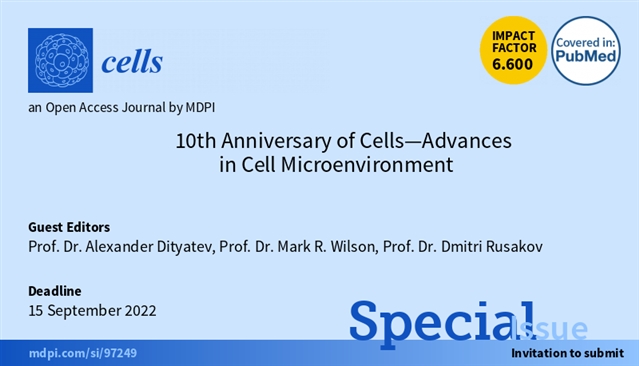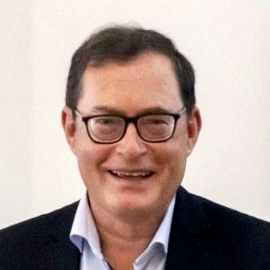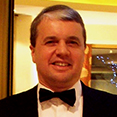The 10th Anniversary Special Issue of Cells
Journal link:https://www.mdpi.com/journal/cells
Wechat link:
https://mp.weixin.qq.com/s? __biz=MzI1MzEzNjgxMQ==&mid=2650057857&idx=3&sn=
72db57e128d88f64a486331165fd36a4&chksm=f1d91645c6ae9f532bd6b2ec1b31b637f
05b71f23072ce580eb4e4e77a249d2f4f1fbc1e3ef4&token=1502473493&lang=zh_CN#rd
2021 is Cells The tenth anniversary of the publication of periodicals. As of now,Cells The journal has published more than 9,300 papers, and its homepage has been visited by more than 50,000 people every month. We support you. Cells The authors, readers, peer reviewers, editors and others who have contributed to the journal express their sincere thanks.

To celebrate this important moment, the journal created a series of commemorative special issues "10th Anniversary of Cells— Advances in Cell Microenvironment ",this special issue invited Professor Alexander Dityatev, Professor Mark R. Wilson and Professor Dmitri Rusakov, experts in the field of cell microenvironment, as guest editors. Related research topics focused on include, but are not limited to: ECM remodeling, mechanical transduction, stem cell niche, tumor microenvironment, neural network and synaptic microenvironment, reconstruction and repair of cell microenvironment with injectable ECM scaffold, gene therapy and pharmacological targeting, experimental modeling of microenvironment using micro-mode and micro-fluid, and system biology of cell microenvironment. We sincerely welcome all scholars and researchers in this field to contribute enthusiastically.
Deadline for submission of special issue: September 15th, 2022.
Guest editor

Prof. Dr. Alexander Dityatev
German Centre for Neurodegenerative Diseases (DZNE)
Prof. Dr. Alexander Dityatev is a professor at the German Center for Neurodegenerative Diseases (DZNE) and the head of the molecular neuroplasticity group. He received his doctorate from the Institute of Evolutionary Physiology and Biochemistry in St. Petersburg, Russia. His research group mainly studies extracellular matrix (ECM), and its potential mechanism involves many mechanisms, including L-type voltage-gated Ca2+ channels, NMDA receptors, Ca2+-dependent K+ channels and the regulation of axonal excitability, focusing on the mechanism of controlling ECM up-regulation and downstream events affecting synaptic and cognitive functions. So far, his article has been cited 8570 times.

Prof. Dr. Mark R. Wilson
University of Wollongong, Australia
Prof. Dr. Mark R. Wilson is a senior professor of chemistry and molecular biology at the University of Wollongong, Australia. He took the lead in identifying and studying extracellular (secretory) mammalian chaperones and their roles in protein’s homeostasis (protein homeostasis). He also conducted basic research on protein homeostasis mechanism of supporting diseases, such as motor neuron diseases. His research team has accumulated expertise in a wide range of technical fields, including confocal microscopy, flow cytometry and the production of recombinant proteins that require a lot of post-translational modifications (such as extracellular chaperones). So far, his article has been cited 6562 times.

Prof. Dr. Dmitri Rusakov
university college london
Prof. Dr. Dmitri Rusakov is a professor at University College London and a member of the synaptic imaging team. He mainly studies the formation and integration of signals in neural circuits of astrocytes, the organizing principles of synaptic structure and function, the activity-dependent control of neurotransmitter release, and the nano-molar landscape of basic Ca2+ in neurons and astrocytes. Its research is helpful for interdisciplinary efforts to solve the cellular mechanism of epilepsy and other neurodegenerative diseases. Up to now, his articles have been cited 8141 times.
Special issue details page:
https://www.mdpi.com/journal/cells/special_issues/Anniversary_Cell_Microenvironment
CellsPeriodical introduction
Editor in chief:
Cord Brakebusch, The University of Copenhagen, Denmark
Alexander E. Kalyuzhny, Neuroscience, USA
It mainly publishes research in cell biology, molecular biology and biophysics. At present, it has been included in databases such as SCIE (Web of Science), PubMed, MEDLINE and PMC.
2020 Impact Factor: 6.600
2020 CiteScore: 6.663
Time to First Decision: 16 Days
Time to Publication: 39 Days

